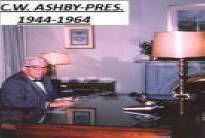






The speechs made at the 1912 opening of the new bridge are very interesting,in particular the one by
Bennet H. Young who built the first bridge (1881-1885). an interesting feature on both bridges was a
turn span on the indiana side shore side ,required by the U.S. Corps of engineers to be opened in high
water situations the span could be turned manually by inserting poles in a spindle, with the men pushing
the poles around like a key. the intricate set of gears slowly opened the span and specifications called for
only six men to be able to do it. a picture of the 1913 trial opening shows more like 20 men turning the spindal
rather than the six in the specs. the bridge was only opened three times. in 1915 in a trial on july 7th ,
then on january 18th, 1916 it let the steamer 'Tarascon" go through, and on march 28th, 1920 the steamer
convict (German) ship "sucess" went through. in 1948 the steamer Gordon & Green was not let through because
telephone and communication lines, etc.would have to be severed, but the K & I and LG&E, had to pay damages
to the boat ownwers. in november 1955 the corp of enginers authorized permenate tie down to the span.
following the 1910 expansion,in 1918 the yards were again expanded, the present day 24stall roundhouse and turntable were built. a new gen. Mgr./chief engineer (promoted to president and general manager in 1938) Mr W.S.Campbell started and exspanded an industial developmentprogram. his twenty-eight year rein (1917-1945) resulted in the K&ITRR serving over 200 industries. perhapes the most notable, the rubbertown complex. following Mr campbell (1944)the next 20 years an astute former Southern R.R. man MR. C.W, Ashby, retained and refined the fine and industrial base by Mr.Campbell. then on board came a former B&O man , MR.JJ GAYNOR,in 1964 and he upheld the fine traditons of the former president/gen managers Mr young, mitchell,campbell, and Ashby untill the southern purchase of 12-31-81
The name change to Kentucky and Indiana Terminal Railroad Company, bears explaining.
In connection with building the new bridge it was decided to expand the Youngstown
yard. this meant streets running east to west between Montgomery and market streets
would have to cross many moore tracks at grage level.It was decided to close some streets,
put in fill embankmments and build viaducks for auto motive traffic to go under the
terminal tracks at montgomery,portland,bank,and market streets. this brought violent
objections from some portland citizens and the newspapers had a field day with this
situation in 1911. it was said portland would be cut off from louisville, and called
the railroad "K&Isville" and referred to Mr. Mitchell as "Baron". however the work
was endorsed by the city, infact , they had proposed the viaducks, but the protest
resulted in the canceling of the orinance whereby the city was to put up $45,000.00
toward the work
Prior to 1900 each road (Southern and B&O ) did their own switching in the youngstown yard with
their own powers. the K&I Bridge company had sold to them small plots within their yard {1 to 3 acres}.
B&O and southern thus had their own small yards and round houses. after the 1900 agreement these
plots were deeded back to the Kentucky Indiana bridge and railroad company. the Monon waited till
the 1910 expantion and new bridge to bring their new albany shop work to the K&Itrr. it was also at
this time that the old K&I shops at 29th and high streets were moved to thr expanded terminal.
the location of the old shops was just north of the tracks across from the old mansion at 2910
northwestern parkway.these old shops burned to the ground in 1915 not having been used after 1910.
|






